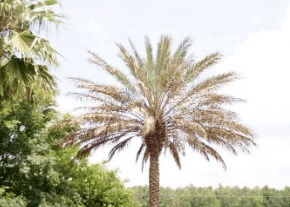Lethal Bronzing Disease (LBD), formerly known as Texas Phoenix Palm Decline (TPPD) is a lethal disease of palms. It is caused by a phytoplasma – a bacterium with no cell wall that lives in the vascular conducting tissue of plants. The disease is transmitted by insect vectors. The pathogen cannot live outside the host or vector, therefore it is very unlikely that the disease is spread on pruning tools.

A Wild Date Palm with Lethal Bronzing Disease.
Symptoms: Premature fruit drop and death of flower stalks is the first noticeable sign of LBD. Lower fronds will then turn bronzish color and brown. LBD also causes roots to rot, so trunks of infected palms may be easy to move when pushed against.
Susceptible species: Palms most susceptible to LBD include Wild Date Palm, Edible Date Palm, Canary Island Date Palm, Senegal Island Date Palm, Sabal Palmetto, and Queen Palm.
Treatment: There is no known cure for LBD. Antibiotic trunk injections with oxytetracycline (OTC) every 3 months can protect healthy palms and may suppress disease if administered in the very early stages.
Replacement of Diseased Palms: Palms symptomatic of LBD should be removed as soon as possible to reduce spread and risk of unstable palms falling over. Another palm may be planted after removal, however it is advisable to select a species that is not susceptible to the disease like the Wodyetia bifurcata (Foxtail palm), Livistona decipiens (Ribbon palm), Livistona chinensis (Chinese fan palm), Roystonea regia (Royal palm), Chamaerops hu-milis (European Fan Palm).
